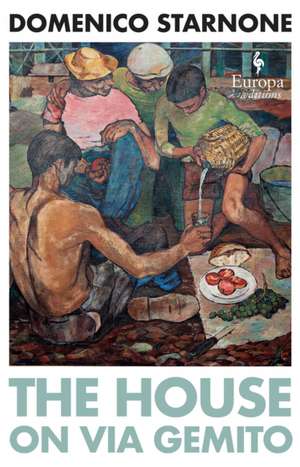The House on Via Gemito
Autor Domenico Starnone Traducere de Oonagh Stranskyen Limba Engleză Paperback – 15 iun 2023
| Toate formatele și edițiile | Preț | Express |
|---|---|---|
| Paperback (1) | 102.81 lei 3-5 săpt. | +18.78 lei 7-13 zile |
| Europa Editions (UK) Ltd. – 15 iun 2023 | 102.81 lei 3-5 săpt. | +18.78 lei 7-13 zile |
| Hardback (1) | 156.94 lei 3-5 săpt. | |
| Europa Editions – 30 mai 2023 | 156.94 lei 3-5 săpt. |
Preț: 102.81 lei
Nou
19.67€ • 21.04$ • 16.40£
Carte disponibilă
Livrare economică 27 martie-10 aprilie
Livrare express 13-19 martie pentru 28.77 lei
Specificații
ISBN-10: 178770453X
Pagini: 480
Dimensiuni: 130 x 209 x 40 mm
Greutate: 0.46 kg
Editura: Europa Editions (UK) Ltd.
Descriere
This extraordinary Strega Prize-winning novel confirms Domenico Starnone's reputation as one of Italy's greatest living writers. Told against the backdrop of Naples in the 1960s, a city that itself becomes a vivid character in this lush, atmospheric novel, The House on Via Gemito is a masterpiece of Italian fiction, one that is steeped in Neapolitan lore.
A modest apartment in Via Gemito smelling of paint and turpentine. Its furniture pushed up against the wall to create a make-shift studio. Drying canvases moved from bed to floor each night. Federí, the father, a railway clerk, is convinced that he possesses great artistic promise. If it weren't for the family he must feed and the jealousy of his fellow Neapolitan artists, nothing would stop him from becoming a world-famous painter. Ambitious and frustrated, genuinely talented but also arrogant and resentful, Federí is scarred by constant disappointment. He is a larger-than-life character, a liar, a fabulist, and his fantasies shape the lives of those around him, especially his young son, Mimi, short for Domenico, who will spend a lifetime trying to get out from under his father's shadow.
Starnone, a finalist for the National Book Award with Trick, author of New York Times notable book of the year, Ties, and the critically acclaimed Trust, takes readers beyond the slim, novella-length works for which he is known by American readers to create a vast fresco of family, fatherhood, and modern Naples.
